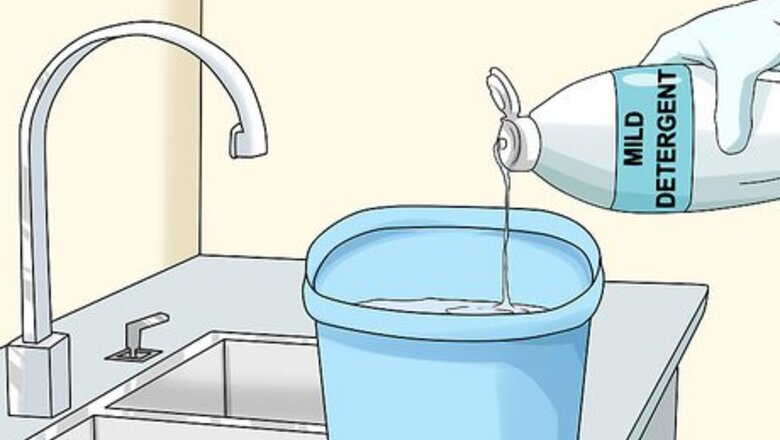
views
Using Soap and Water
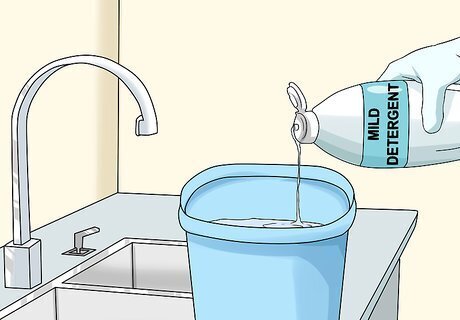
Mix up a mild soap solution. Run a few ounces of warm water into a large, open container. Add about two teaspoons of liquid dish detergent and stir until the soap is completely dissolved. The goal is to produce a very gentle solution you can use to wipe down your jacket without damaging it. Too much detergent can cause the leather to deteriorate and strip it of dyes, resulting in a blotchy, discolored appearance.

Wet a soft towel or sponge. Submerge the towel or sponge in the soapy solution. Wring out the excess liquid. The towel or sponge shouldn’t be sopping wet, just damp. If it’s too wet, the water can soak into and saturate the leather, potentially causing even more damage. Use a soft cloth. Rough fabrics may leave scratches on soft leather if you’re not careful. A microfiber cloth is ideal.
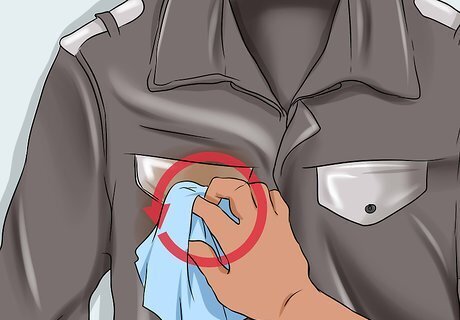
Wipe down the outside of the jacket. Run the damp towel or sponge in long, smooth motions rather than forcefully scrubbing. Pay particular attention to water spots, discolored patches, and places where dirt or oil has built up on the leather. Clean the entire jacket, re-wetting the towel when needed.
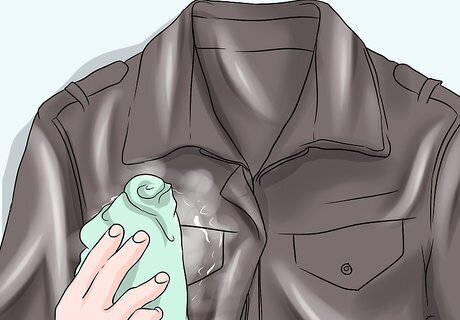
Clean off the soap and pat the jacket dry. Wipe the jacket again, this time using clean water to clear away any soap residue. Make sure there’s no standing water remaining on the jacket. With a dry towel, pat the leather until it is completely dry. Hang the jacket up in a closet and allow it to finish drying. Direct heat can be very bad for leather, especially if it has just been moisturized, so don’t dry the jacket in a machine or use a blow dryer.
Using a Leather Cleaner
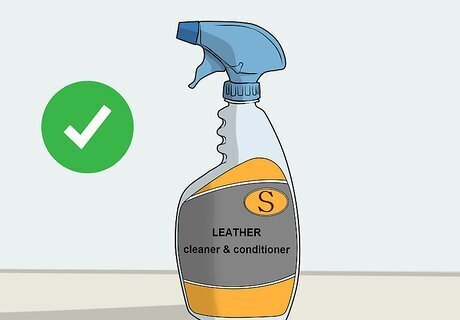
Purchase a specialty leather cleaner. These contain ingredients that scrub away dirt and stains, and oils that help soften the leather and keep it healthy. You can typically find leather cleaners at superstores, along with any place that specializes in leather. A bottle of leather cleaning solution only costs a few dollars and is likely to last for years.
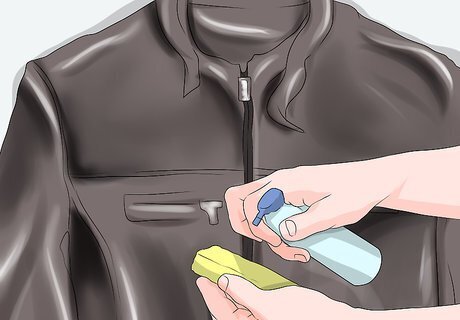
Apply the leather cleaner to the jacket. Squirt a dime-sized glob of leather cleaning solution onto the dirty part of the jacket. Some leather cleaners are gels, sprays, or bars. If you’re using any of these other kinds, always start with a minimal amount of cleaner and apply more as needed.
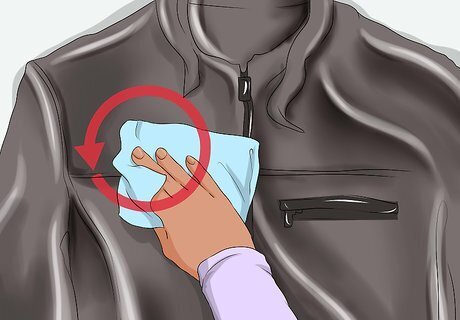
Rub the cleaning solution into the leather. Take a soft, clean towel and massage the leather cleaner into the surface of the jacket. Use slow circular strokes, rubbing outward in a spiral. As you work the cleaner in, it will collect dirt and remove water spots that have set into the leather. Rub until the cleaner has been absorbed entirely.
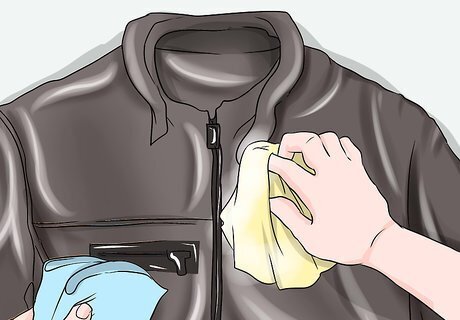
Remove excess solution. Use a separate towel to wipe off any leather cleaner remaining on the jacket. The jacket should have a clean, rich sheen to it when you’re finished. Afterward, your jacket will look like new and the leather will be moisturized and protected, keeping it in good shape for months. Since it’s designed to be soaked into dry, chapped leather, there’s no need to rinse away leather cleaner once it’s been applied. Leather cleaners are formulated to get the job done with minimal effort, but you may have to apply the cleaner several times if the jacket is very dingy.
Caring for Your Leather Jacket
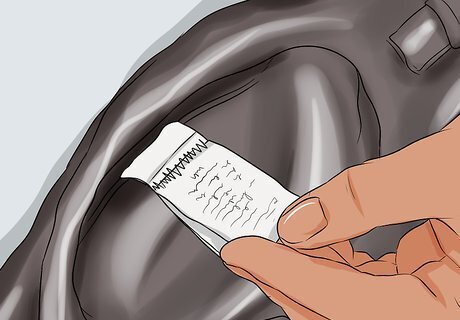
Check the manufacturer’s instructions. Read the label inside the jacket. The manufacturer will have provided specifications according to the type and grain of leather, and any important warnings. In most cases, the manufacturer will suggest a preferred cleaning method. It’s a good idea to stick to this in order to avoid ruining your jacket.
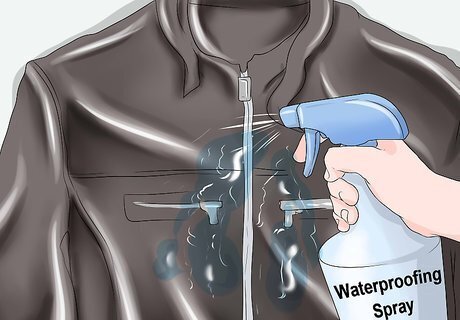
Waterproof your jacket to prevent damage. No matter what kind of leather jacket you own, you should spray it periodically with a waterproofing agent. This seals the pores in the leather. Water will simply bead and roll off the leather, and the jacket will be no worse for wear. Ideally, you should waterproof a leather jacket as soon as you get it. Wear a different jacket if the forecast calls for rain. Too much moisture can shorten the life of your leather jacket.

Treat your jacket with leather conditioners. Once a year or so, apply a leather conditioning cream to the entire outer surface of your jacket. Conditioning your jacket defends it from moisture, leaves it soft and flexible, and prevents cracking and splitting. You can also try giving it a good rub down with a bar of saddle soap. This may be too harsh for soft or thin leather but will work like a charm on sturdy, rugged jackets.

Have soft leathers professionally cleaned. To avoid damaging them, do not clean jackets made of soft or textured leather-like lamb or suede at home. A qualified leather expert will have the knowledge and equipment to rid your jacket of even the most stubborn stains, and you won’t have to worry about tearing or shrinking the leather. Dry cleaning leather isn’t cheap, but under most circumstances, you won’t need to have it done more than once a year or so. Suede jackets can be kept clean by dusting them regularly with a hand brush.

Store your jacket properly. Keep your jacket laid out or draped on a hanger when you’re not wearing it. Put it in a cool, dry place. Clean and condition the jacket once a year. As long as you take good care of your leather jacket, it will stay in top condition for years and years, and may even outlast you. If you don’t wear your leather jacket very often, put it in a garment bag. If your jacket is wrinkled from storage, place a towel over it and iron it on medium heat, or hang it up in the bathroom with you when you take a hot shower. The heat and moisture will relax the wrinkles naturally.














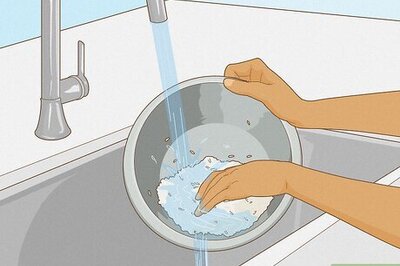


Comments
0 comment